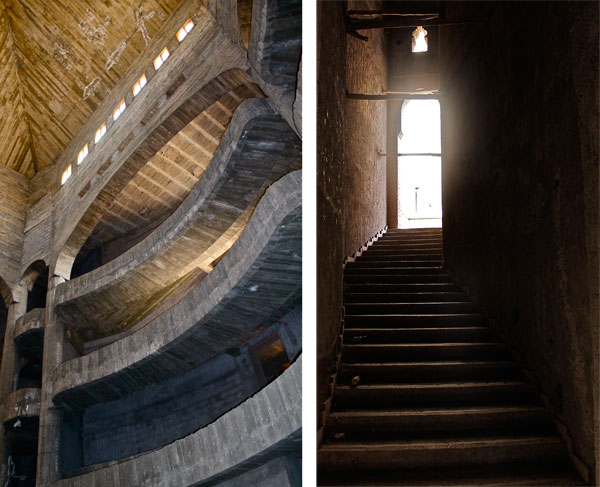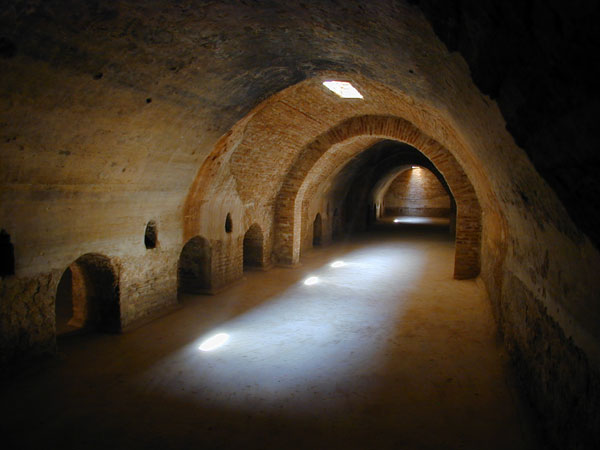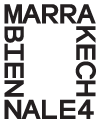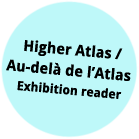أعلى من الأطلس HIGHER ATLAS
High connotes reverie and transcendence: Higher Atlas suggests a cartography of the beyond. The title also refers to surrounding geography, as the Atlas Mountains are visible from all the biennial sites. In this respect, the exhibition is a starting point for a series of trips, both virtual and physical; Other worlds begin at one’s feet. This thesis is explored through site-specific art, architectural, musical and textual interventions. A layered context emerges from the particularity of the exhibition experience, articulating the blurred boundaries between historically discrete spheres, and the conjunction of local and global conditions.
Dispersed among the Théâtre Royal, a building that remains incomplete; the Koutoubia cisterns, which lie beneath the foundations of a previous mosque; the Bank Al-Maghrib building, located on the south side of the perpetually bustling Djemaa el-Fna square; the Cyber Parc Arsat Moulay Abdeslam; and at Dar Al-Ma’mûn foundation, Higher Atlas engages Marrakech by underlining the contemporary relevance of civic, rural and historical sites through the work of international participants. The exhibition, which features work from 37 participants, constitutes a shared platform for diverse demographics, initiating dialogues that produce new, consensual realities.

Théâtre Royal. Photos by Alia Radman
MARRAKECH BIENNALE
Marrakech Biennale is a Moroccan biennale of contemporary international culture. In February of 2012, Marrakech Biennale will launch its fourth edition, Free Thinking Surrender, featuring key figures in literature, film and visual arts. From the 29th Feburary – 4th March 2012, public screenings, talks, performances and debates will take place at venues around the city. Higher Atlas, an exhibition curated by Carson Chan and Nadim Samman, will be on view until June 3, 2012. Alan Yentob, creative director of the BBC, returns this year as the organizer of the film program, and Omar Berrada with Elizabeth Sheinkman will organize the literature events.
With each biennial, Marrakech Biennale strives to collaborate with local universities and craftsmen, to build a platform that promotes Marrakech’s position within the international sphere. Through partnerships with African and international voices, the Biennale aims to support a Moroccan cultural identity that is both locally rooted and internationally relevant. Developed for this upcoming edition, the Marrakech Biennale will establish workshops for children lead by local and international cultural practitioners to promote access to contemporary culture for all ages. These three months aim to highlight Morocco as a dynamic hub for current ideas and to establish its continued intellectual involvement on an international stage.
Past participants have included Francis Alys, Yto Barrada, John Boorman, Richard E. Grant, Edmond El Maleh, Tracy Emin, Pieter Hugo, Isaac Julien, Abdellah Karroum, Joseph Kosuth, Julien Schnabel, Zadie Smith, Abdellah Taia.
In 2004 with the rise of global tensions, Vanessa Branson envisioned a cultural festival that would address social issues through the arts, using them as a vehicle for debate and discussion and to build bridges between diverse ideologies. Marrakech Biennale would become a celebration of creativity in a city that has been the focus of artistic exploration for centuries but with limited emphasis on contemporary art. Begining in 2005, as a gathering of arts enthusiasts who organized literary events and exhibitions. Marrakech Biennale has grown to become an internationally recognised biennale with a thriving visual arts, film and literature programme. The festival’s role has evolved along with the climate of the times. With today’s events in North Africa, the organization’s goals could not be more pertinent for the cultural identity of the region. This festival aims to show the outside world that Morocco is an open society that encourages freedom of expression and debate, as well as sponsoring significant and lasting benefits for the area and its inhabitants, socially, economically and culturally.
Vanessa Branson
President
Jessica Bannister
Marrakech Biennale Manager
Mohammed Bakrim, Suzy Gillett, Vincent Melilli, Alan Yentob
Film Program Organizers
Omar Berrada, Benedicte Clarkson, Elizabeth Sheinkman
Literature Program Organizers
Nadim Samman
Visual Arts Program Curator
Carson Chan
Curator
Marie Egger
Curatorial Assistant
Maria Sebnat-Martin
Outreach Coordinator
Alia Radman
Project Coordinator
Alya Sebti
Moroccan Art Specialist
Salima Hadimi, Lucy O’Regan
Production Assistant
Moulay Essakalli, Julie Klear (Zid Zid Kids)
Children Workshops
Nine Eglantine Yamamoto-Masson
Djemaa el-Fna Video Program Curator
Sara Hartman, John McCusker (Vaguely Contemporary)
Graphic Design, Marrakech Biennale [4] Reader
ourwork.is
Website Design, Higher Atlas
Jody Gillett
Press Relations
Housseine Angmar, Nabila Chtioui, Khadija Chouiqar, Oumayma Benabbou, Houda Boufada, Mohamed Bousaadi, Noureddine Douakhech, Samira Ed Dayry, Hanane el Gouze, Dounia el Haddaji, Mouna el Khachachab, Omar Ait M’hamed, Amandine Mestre, Mouna Naim, Layla Noumghar, Abdellilah El Off ati, El Houssaine Ait Omar, Oumayma Ouatlil, Fatima Oubella, Zineb Ousbaa, Mustpha Rabati, Hakima Sadiq, Sarah Safhi
Interns

Koutoubia Cisterns.


